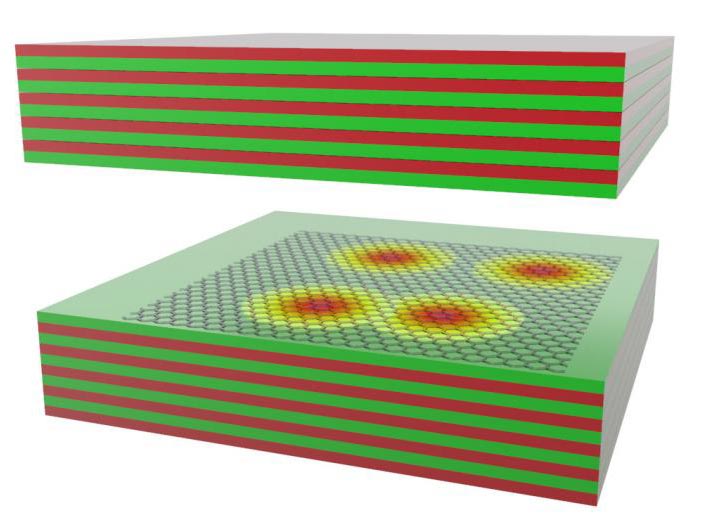CCNY team makes single photon switch advance

Schematic of the optical microcavity with 2D semiconductor. The nonlinear optical response arises from the larger Bohr radii Rydberg excitons allowing to push the limit to few photon nonlinear limit.
Image credit: Rezlind Bushati
The ability to turn on and off a physical process with just one photon is a fundamental building block for quantum photonic technologies. Realizing this in a chip-scale architecture is important for scalability, which amplifies a breakthrough by City College of New York researchers led by physicist Vinod Menon. They’ve demonstrated for the first time the use of “Rydberg states” in solid state materials (previously shown in cold atom gases) to enhance nonlinear optical interactions to unprecedented levels in solid state systems. This feat is a first step towards realizing chip-scale scalable single photon switches.
In solid state systems, exciton-polaritons, half-light half-matter quasiparticles, which result from the hybridization of electronic excitations (excitons) and photons, are an attractive candidate to realize nonlinearities at the quantum limit. “Here we realize these quasiparticles with Rydberg excitons (excited states of excitons) in atomically thin semiconductors (2D materials),” said Menon, chair of physics in City College’s Division of Science. “Excited states of excitons owing to their larger size, show enhanced interactions and therefore hold promise for accessing the quantum domain of single-photon nonlinearities, as demonstrated previously with Rydberg states in atomic systems.”
According to Menon, the demonstration of Rydberg exciton-polaritons in two-dimensional semiconductors and their enhanced nonlinear response presents the first step towards the generation of strong photon interactions in solid state systems, a necessary building block for quantum photonic technologies.
Jie Gu, a graduate student working under Menon’s supervision, was the first author of the study entitled: “Enhanced nonlinear interaction of polaritons via excitonic Rydberg states in monolayer WSe2,” which appears in “Nature Communications.” The team also included scientists from Stanford, Columbia, Aarhus and Montreal Polytechnic universities.
The research of Professor Menon and his co-workers could have a tremendous impact on Army goals for ultra-low energy information processing and computing for mobile Army platforms such as unmanned systems,” said Dr. Michael Gerhold, program manager at the U.S. Army Combat Capabilities Development Command, known as DEVCOM, Army Research Laboratory. “Optical switching and nonlinearities used in future computing paradigms that use photonics would benefit from this advancement. Such strong coupling effects would reduce energy consumption and possibly aid computing performance.
###
The research was supported by the Army Research Office, an element of DEVCOM Army Research Laboratory, through the MURI program and the NSF through the MRSEC program.
All latest news from the category: Materials Sciences
Materials management deals with the research, development, manufacturing and processing of raw and industrial materials. Key aspects here are biological and medical issues, which play an increasingly important role in this field.
innovations-report offers in-depth articles related to the development and application of materials and the structure and properties of new materials.
Newest articles

Trotting robots reveal emergence of animal gait transitions
A four-legged robot trained with machine learning by EPFL researchers has learned to avoid falls by spontaneously switching between walking, trotting, and pronking – a milestone for roboticists as well…

Innovation promises to prevent power pole-top fires
Engineers in Australia have found a new way to make power-pole insulators resistant to fire and electrical sparking, promising to prevent dangerous pole-top fires and reduce blackouts. Pole-top fires pose…

Possible alternative to antibiotics produced by bacteria
Antibacterial substance from staphylococci discovered with new mechanism of action against natural competitors. Many bacteria produce substances to gain an advantage over competitors in their highly competitive natural environment. Researchers…





















